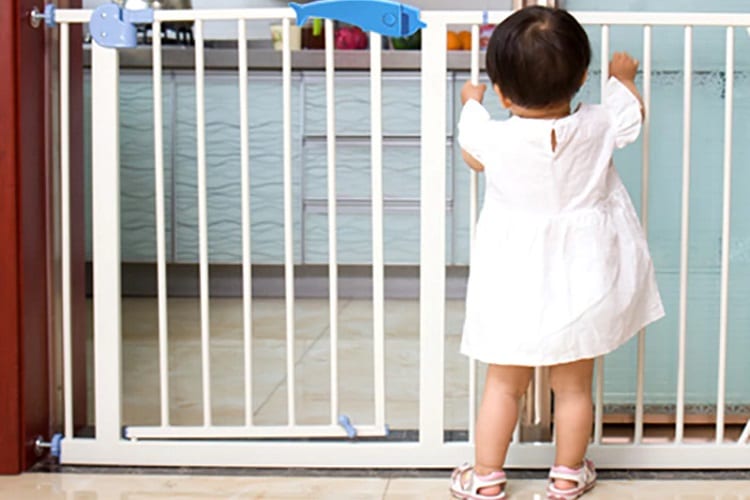While you can still buy one, a DIY baby gate is a great way to save money and create a gate that is perfect for your needs. You can choose the size, the height, and the style to make sure it blends in with your home décor.
Provided that you have the necessary equipment and a bit of some carpentry skills, you can build your own DIY baby gate in a few simple steps – and it will go a long way to baby-proof your home!
In this article, we will be providing you with a guide on how to build your very own DIY baby gate.
Contents
What You’ll Need:
– Nail Gun or Hammer
– Square
– Level
– Chisel
– Putty knife
– Wood filler
– Saw
– Drill
– Paintbrush
– Ruler
– Jigsaw
– Sandpaper
– Safety Gate Hardware
Materials:
– 1″ x 2″ x 8′ Pine Board (5 Pieces)
– Gate Hinges (Two Pairs)
– Gate Latch
– Acrylic Paint and Varnish
– Wood glue
– Nails or 2-1/2-inch screws.

Step 1: Measure The Opening
The length of your DIY baby gate is determined by the width of the opening you wish to close. The typical height of a baby gate is 24 to 28 inches, so anything in that range should work. After you’ve got the dimensions of the DIY baby gate, cut the wood for its outer frame.
Step 2: Cut the Boards
The next step is to cut the boards to the desired length. You should cut the wood based on the top and bottom measurements of the baby gate’s opening.
Cut 1x2s to the desired length for the top and bottom of the gate; then, cut two wood trim pieces three inches shorter than your gate’s height (twice as thick as the timber).
For us, the walk away is about 40 inches wide and we want the gate to be 28 inches tall. That means we will cut two 1″ x 2″ x 40 inches to go to the top and bottom of the gate and two 1″ x 2″ x 25 inches for the side pieces. Keep in mind that you have to deduct the inches taken by the top and bottom pieces of lumber.
Once you cut, give the pieces a nice sanding. You want everything to be nice and smooth before you start assembling your DIY baby gate.
Step 3: Assemble The Gate Frame
Take your two side pieces and attach them to the top and bottom pieces with glue and nails or screws. Make sure everything is flush and in line with each other. You can use a level or square to help with this.
Tip: To avoid the wood from cracking, use a fine drill bit for the project.
Step 4: Measure The Length Of The 1 x 2 Pieces
You now have the perimeter of the gate. Next is to fill it in with a 1″ x 2″ piece of lumber.
Here, you’ll need to choose your favorite pattern. For our case, we will go with a 45-degree angle design with the pieces connecting from the bottom left corner to the upper right corner. Let’s work with the bottom part of the diagonal and leave the space at the top for now.
In case you want to go by this, using a protractor and a ruler, lay the 1″ x 2″ pieces out on your rectangular frame to get the first angle and maintain uniform spacing. To ensure that the 1x2s fit neatly inside the frame, mark with a pencil exactly where they meet the frame using the straight edge of the ruler.
Beware of the spaces you leave between the boards. You’ll want to make sure that a baby’s hand or foot can’t fit through there.
If everything looks good, attach the pieces with glue and nails or screws. Again, be careful to use a level and square as you go along to keep things nice and straight.
Step 5: Cut
Next is to cut the pieces in the marked areas. This is where the jigsaw will come in handy. If you’re not comfortable using one, ask somebody for help or consider hiring a professional to do the job for you.
Once you cut, again sand the edges to make sure they’re smooth. Then, fill the edges into the frame, each in its appropriate spot.
Step 6: Mark Nail/Screw Spots
If you cut them precisely, the pieces should fit snugly into the frame. Mark two spots for screws in pencil on the outside of the frame everyplace the diagonals 1x2s come into contact with the frame. Then, predrill the place with a fine drill bit to avoid splitting the wood.
Remove the pieces again, apply glue, place them back into the frame, and then drive nails or screws.
Step 7: Fill The Top Space
Close the top left corner of the gate with a pair of 1x2s, which should be placed perpendicular to the rest of the diagonal pattern. Make a line where each meets up with the frame and then cut them to size.
Much like with the first pieces, sand these, put them back, make nail – or screw – marks, and drill. Then, remove the pieces, apply wood glue into two the two ends, return, and install fasteners.
If you notice any gaps where the diagonal pieces of wood meet, apply wood filler with a putty knife.
Step 8: Sand The Whole Piece
Once all the woodwork is complete, give the entire gate a good sanding. Start with medium grit and then finish up with fine-grit sandpaper. Be sure to get into all the nooks and crannies for a nice and smooth surface.
If you’re using acrylic paint, you can apply it now. Choose the color that dovetails with your decor.
You need two coats here. Ensure that you leave the first coat to dry up before applying the second one.
Once the paint is dry, it’s time now to dress it up with transparent acrylic varnish. This will help to seal the wood and protect it from scratches and everyday wear and tear.
Step 9: Get The Opening Direction Right
The rule of thumb is that a door should open into the room. However, that isn’t cast in stone, so you can open it in whichever way you prefer. Just be sure that when you’re installing the baby gate, you place it so that the opening is facing the way you want it to open.
Place one leaf of each hinge on the top and bottom of the appropriate side of your gate, two inches from the top and bottom. Attach your gate by hoisting it a few inches off the ground and screwing in the other hinge leaves into the wall.
You may need a third hand in this step since your two hands will be busy with the tool and the hinge. If so, use a helper or ask somebody to hold the gate for you. Once you are done with the gate hinges, you can now attach the door handle.
And Voila! You’re Done!
There you have it – a DIY baby gate that’s both attractive and functional. You can customize it to fit your specific needs and preferences, and you’ll have the satisfaction of knowing that you built it yourself. Now all you need is a little one to test it out on!


